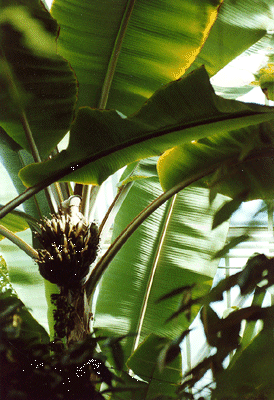Greenhouses - House C

House C contains tropical crop plants and other useful plants, altogether about 250 species, arranged according to main uses. Starch plants include manioc, rice, yams, taro, the legendary bread-fruit tree, and sweet potatoes. Tropical plants with edible fruits are banana, pawpaw, pineapple, coconut, carambola, guayava, and tamarind. Other important crops plants are cocoa, coffee, and sugar cane. A tropical fruit tree, but much more known for the use of its latex collected from the trunk, is the chicle tree, Manilkara achras, from Central America. [Photo: Banana plant (Musa)] Among the fibre plants, the most important like cotton and sisal are present, as well as Boehmeria nivea, Musa textilis, Sansevieria spp., and the palm Carludovica, from which Panama hats are made. Members of the cucurbit family, mostly herbaceous climbers, have remarkably multiple uses. Wax gourd (Benincasa hispida), bottle gourd (Lagenaria siceraria), and loofah (genus Luffa) can be found here in summer. Other conspicuous climbers are Dioscorea spp. with tuberous roots, and some members of the bean family. Plants providing spices include vanilla, chili pepper, black pepper, and cinnamon. B. Leuenberger |
Continue the tour of the greenhouses...





